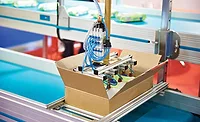How to use less water for beef processing without compromising food safety
While keeping busy is a good thing, high levels of production require additional use of resources including antimicrobials, water and overall energy.

Now that drought conditions in cattle-raising states have subsided and beef production has increased, beef processing facilities are running at or near capacity. By the end of 2018, total beef production is expected to grow five percent year over year. While keeping busy is a good thing, high levels of production require additional use of resources including antimicrobials, water and overall energy.
Beef processing requires more water per pound than any other type of protein and, the biggest users of water are the carcass washing cabinets used as interventions, which can go through 300 gallons or more per minute. That equates to hundreds of thousands of gallons a day.
Over the last two decades, carcass wash cabinets haven’t improved much in terms of design and efficiency, but that’s changing. Equipment manufacturers across the industry are working to develop ways of building cabinets that provide more precision and control, helping processors reduce water usage while also washing more thoroughly.
Improvements are coming to food safety chemistry as well. Innovations such as new formulations and creative ways to apply antimicrobial chemicals will help processors do more with less product.
Automation is making it easier for beef processors to meet efficiency and sustainability goals while catching problems before they get worse. Reporting functionality in automated sanitation solutions, for example, makes recordkeeping easier, allows for setting benchmarks and can indicate when a resource such as water is being overused when compared to typical data.
As bright as the future may look in terms of efficiency and sustainability, beef processors need advice for conserving water now. Here are some of the best places to start.
First, conduct a detailed review of your standard processes for carcass washing. Can the temperature and volume levels be adjusted to improve efficiency? Are the nozzles the right size and in good working condition?
Looking for quick answers on food safety topics?
Try Ask FSM, our new smart AI search tool.
Ask FSM →
Nozzles are a common issue that lead to wasted water. Their orifices wear out over time, allowing more gallons per minute to spray than necessary. Through routine maintenance, nozzles should be checked monthly and replaced every six months to one year depending on if you’re running a single or double shift plant.
Damage to swivel assemblies also leads to wasted water. Third shift sanitation workers sometimes use cabinet spray pipes like a ladder. That can create a kink in the assembly that starts to leak.
Water waste in protein processing can be avoided when you give your maintenance crew dedicated time to look for potential problems. So, while the industry is developing processing and food safety solutions, efforts to conserve resources can have a positive impact on your bottom line and the environment.
Bob Ogren is vice president of equipment at Birko, the leading provider of food safety chemistry, equipment and technology. It’s patented Chad Carcass Wash and Water Smart systems are trusted by the top beef processors in the U.S.









